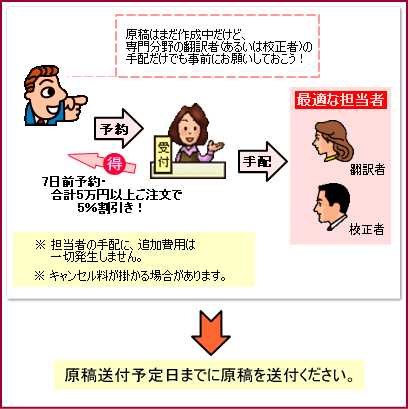お手軽・安心・お得な!
論文翻訳、校正ご予約サービス

エクスコムシステム・ランゲージ・サービスでは、
翻訳、校正等、すべてのサービスでご予約を受付けております。

※各種注意事項はこちら
※キャンセル時の注意事項はこちら


| メリット1: |
専門分野に精通した担当者の確保が事前に可能となります。
この担当者の事前手配に追加費用は一切発生いたしません。
※ご予約は、なるべく原稿送付日の2日前までにお願いいたします。
直前予約では、最適な担当者確保が困難な場合がございます。
|
| メリット2: |
原稿送付の7日前までにご予約いただき、
合計料金が5万円以上のお客様へは、
5%割引にてサービスをご提供いたします。
※受付は日本総合窓口営業時間内にて(平日:10時〜18時)
上記時間外の受付分は、翌営業日扱いとなります。 |
下記フォームに必要事項をご記入の上、ご予約ください。
折り返し、担当者より確認のメールを送らせていただきます。

※ 各種注意事項
1) 予約サービス受付について
予約サービスは、日本窓口の営業時間内にて受付いたします。
(平日午前10時〜午後6時まで)
また、予約サービスは、なるべく原稿送付予定日の2日前までにはお申込下さい。
1日前、当日では最適な担当者確保が困難な場合がございます。
直前のお申込の場合は、通常のお申込扱いとさせていただく場合がありうることをご了承ください。
|
2) 納期について
最適な担当者を確保しても、短納期では品質確保が望めません。
納期には十分余裕を持ってお申込ください。極度の短納期のものはお受け兼ねる場合がございます。
|
3) ご依頼内容の変更について
実際のご依頼内容が、予約時のものと異なる場合には、原稿送付予定日の2日前までに日本窓口へ営業期間内にご連絡をお願いいたします。著しく異なる場合には、対応いたしかねる場合がございます。
|
4) 原稿送付予定日の設定、および変更について
・ 原稿送付予定日は、日本窓口の営業日である平日にご設定願います。週末および祝日をご設定の場合は、翌営業日扱いとなります。
・ 原稿送付予定日が予約時より変更(遅延等)になる場合は、必ず予定日の2日前までに日本窓口の営業時間内にご連絡ください。その際には、一旦ご予約を取り消させていただきますので、新たにご予約いただくか、通常のご依頼方法にてお申し込みください。
|
※ご連絡は日本総合窓口の営業時間内で受付いたします。(平日: 10時〜18時)
営業時間外のご連絡分につきましては、翌営業日扱いとなりますのでご注意ください。
※ キャンセル時の注意事項
キャンセルの際は、原稿送付予定日の2日前の夕方18時までにご連絡ください。
それ以降のキャンセル時には、下記キャンセル料金をお支払いただきます。
原稿送付予定日の
2日前の18時〜前日のキャンセル
|
合計金額の12.5%のキャンセル料 |
原稿送付予定日の
当日キャンセル |
合計金額の25%のキャンセル料 |
※ご連絡は日本総合窓口の営業時間内で受付いたします。(平日: 10時〜18時)
営業時間外のご連絡分につきましては、翌営業日扱いとなりますのでご注意ください。
エクスコムシステムランゲージサービス(ELS)
英語論文翻訳 ( 英日、日英 )、英語論文校正 ( 英文校正 )、各種言語の論文翻訳、校正、ネイティブチェックサービスについてのお問い合わせは、日本国内代表者連絡先 honyaku@excom-system.com までご連絡ください。
英語翻訳 ( 和英、英和、日英、英日、論文翻訳等 )、英文校正、多言語翻訳、多言語校正、ネットスクール形式の英文ライティング指導等の総合サービス。
英語翻訳や英文校正をお考えの場合は、本ページの 『 翻訳 校正 予約サービス 』 をご覧ください。専門分野に精通した翻訳者や校正者の事前確保が可能になります。優秀な翻訳者や校正者は引く手数多です。お早めにご予約いただければ、スケジュール調整が容易になり、最適の翻訳者、校正者がお客様の大切なご依頼文書を担当させていただきます。急な御用命の場合には、ご依頼文書の分野を専門とする翻訳者や校正者の手配が難しい場合もありますので、『 翻訳 校正 予約サービス 』をお役立ていただければ幸いです。
Using plurals to avoid gender bias
Some writers use s/he, him/her, and other such constructs. In using the constructs writers offer balanced gender, but the constructs do not provide good English. They are awkward and interrupt the lyrical flow of language. Example 1 is an example.
Example 1: The individual voter makes her/his choice on the basis of information presented to her/him. S/he may decide in a moment or s/he may take several days, weeks or months to make her/his choice.
Another option is to use plurals, which often help to improve the flow of language and avoid gender bias.
Example 2: Individual voters make their choices on the basis of information presented to them. They may decide in a moment or they may take several days, weeks or months to make a choice.
Example 2 language flows without interruption. Making decisions about style is the author’s prerogative. Still, style decisions are framed by style requirements of journals and other publications and by standard usage. Within that frame, using the plural to avoid gender awkwardness is a style decision, and we believe a good choice.
Some writers appreciate the plural, while others do not. They may argue that the singular is stronger. Example 3 provides another option.
Example 3: One individual voter makes choices on the basis of information presented. The voter may decide in a moment or may take several days, weeks or months to make a choice.
Example 3 sidesteps gender imbalance through using one and avoiding pronouns.
One word of caution: Most contemporary publications require gender balance, and many of us wordsmiths have a bias against those who write using male pronouns.
ページの先頭に戻る
エクスコムシステム ランゲージ サービス(ELS) Copyright 2014無断転載禁止。
|